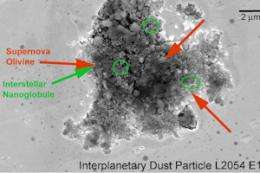Scientist uncovers relics of ancient cosmos

(�鶹��ԺOrg.com) -- A University of Manchester scientist, working as part of an international team, has uncovered an unexpectedly rich trove of relicts from the ancient cosmos.
Dr Henner Busemann from The School of Earth, Atmospheric and Environmental Sciences has uncovered minute grains in stratospheric dust that may have formed inside stars that lived and died long before the birth of our sun.
Dust samples collected by high-flying aircraft in the upper atmosphere have also yielded material from molecular clouds in interstellar space, reports Dr Busemann and colleagues in the journal Earth and Planetary Science Letters.
This ‘ultra-primitive’ material is likely to have wafted into the atmosphere after the Earth passed through the trail of the Grigg-Skjellerup comet in 2003.
The interplanetary dust particles (IDPs) used in the study were collected by NASA aircraft in April 2003, after the Earth passed through the dust trail of the comet.
The research team, which included several Carnegie Institution of Washington scientists, analysed a sub-sample of the dust to determine the chemical, isotopic and microstructural composition of its grains.
The results are reported online in Earth and Planetary Science Letters.
“We found an extraordinary wealth of primitive chemical ‘fingerprints’, including abundant pre-solar grains. This is true stardust that has formed around other earlier stars, some during supernova explosions, associated with extremely pristine organic matter that must pre-date the formation of our planets,” said Dr Busemann.
The distinctiveness of the particles, plus the timing of their collection after the Earth’s passing through the comet trail, point to their source being the Grigg-Skjellerup comet.
“This is exciting because it allows us to compare on a microscopic scale in the laboratory dust particles from different comets. We can use them as tracers for different processes that occurred in the solar system four-and-a-half billion years ago,” added Dr Busemann.
"These tiny grains combine all the most primitive features, found to date only separately in various meteorites, samples from the previous Stardust mission and interplanetary dust particles. The particular collection scenario allows us speculate that we truly have samples of a known source in our hands.”
The primitive matter, containing unaltered samples of the building blocks of our Solar System, gives significant insights into the turbulent processes leading to its formation and also the fate of comets orbiting since their formation at the outer edges of our planetary system.
Comets are thought to be repositories of primitive, unaltered matter left over from the formation of the solar system.
While the planets in the inner solar system, such as Earth or Mars, once experienced harsh conditions and have changed substantially over the past 4.5 billion years, comets are believed to store the original material of the early Solar System, acting as ‘supersized refrigerators’.
The interplanetary dust particles, which are only a few thousands of a millimetre in diameter, were analysed by an international collaboration from the UK, the US and Germany.
Scientists in the Cosmochemistry research group in the School of Earth, Atmospheric and Environmental Sciences have also been involved in analysing small fragments of material from the Wild 2 comet, which was brought back to earth by NASA's Stardust space mission.
The Stardust mission was launched into space in early February 1999 and encountered Comet Wild 2 in 2004, while nearly 242 million miles from earth.
The NASA mission returned particles captured from the comet in 2006 - the first grains of cometary dust ever returned to earth.
More information: The full journal paper reference is Busemann, H., et al., Ultra-primitive interplanetary dust particles from the comet 26P/Grigg-Skjellerup dust stream collection, Earth Planet. Sci. Lett. (2009),
Provided by University of Manchester ( : )


















